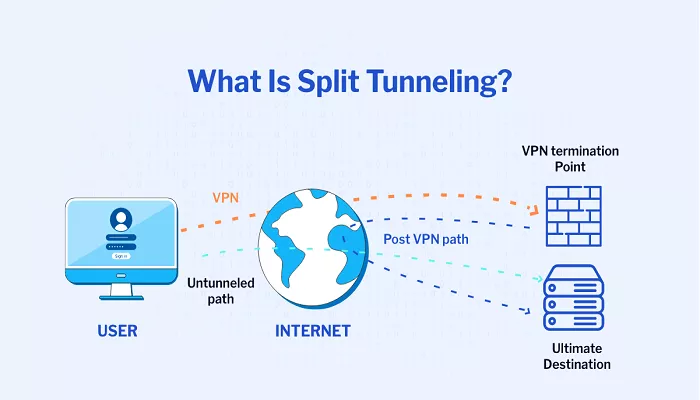In today’s digital age, maintaining online privacy and optimizing internet performance are top priorities for many users. One effective way to achieve both is through a feature known as split tunneling. This feature is commonly found in Virtual Private Networks (VPNs) and offers users greater control over their internet traffic.
What Is Split Tunneling?
Split tunneling is a VPN feature that allows users to route some of their internet traffic through an encrypted VPN tunnel while sending the rest through their regular internet connection. This means that users can access secure resources through the VPN while simultaneously using the internet without encryption for other activities. This approach provides flexibility and can enhance both security and performance.
How Does Split Tunneling Work?
When you connect to a VPN, all your internet traffic typically passes through the VPN server, ensuring encryption and privacy. However, with split tunneling enabled, you can specify which applications or websites should use the VPN and which should connect directly to the internet. This is achieved by configuring routing rules that determine the path each data packet takes.
For example:
- VPN Tunnel: Your email client and file-sharing applications route their traffic through the VPN to access secure company resources.
- Direct Connection: Your web browser accesses websites directly without the VPN, allowing for faster browsing speeds.
This selective routing ensures that sensitive data is protected while optimizing performance for less critical activities.
Types of Split Tunneling
Split tunneling can be implemented in various ways, depending on user needs and VPN capabilities:
1. Application-Based Split Tunneling
Allows users to specify which applications should use the VPN and which should not. For instance, you might route your torrent client through the VPN while letting your web browser connect directly to the internet.
2. URL-Based Split Tunneling
Enables routing traffic to specific websites through the VPN. This is useful when you want to access geo-restricted content on certain sites while browsing other sites without the VPN.
3. Inverse Split Tunneling
The default setting routes all traffic through the VPN, but with inverse split tunneling, only specified traffic is encrypted, and the rest bypasses the VPN. This approach is less common but can be beneficial in certain scenarios.
Benefits of Split Tunneling
Implementing split tunneling offers several advantages:
1. Improved Performance
By routing only necessary traffic through the VPN, you reduce the load on the VPN server, leading to faster internet speeds for non-sensitive activities.
2. Access to Local Resources
Split tunneling allows you to access local network devices, such as printers or file servers, without disconnecting from the VPN.
3. Reduced Bandwidth Usage
Since not all traffic is encrypted, there’s less data to process, conserving bandwidth and reducing latency.
4. Bypass Geo-Restrictions
You can access region-specific content through the VPN while maintaining local internet access for other activities.
Risks and Considerations
While split tunneling offers benefits, it’s essential to be aware of potential risks:
1. Reduced Security
By allowing some traffic to bypass the VPN, you may expose sensitive data to potential threats.
2. Complex Configuration
Setting up split tunneling requires careful configuration to ensure that only intended traffic is routed through the VPN.
3. Compatibility Issues
Not all VPN providers support split tunneling, and some applications may not function correctly when split tunneling is enabled.
How to Enable Split Tunneling
Enabling split tunneling varies depending on your VPN provider and device:
- Check VPN Compatibility: Ensure your VPN provider supports split tunneling.
- Access Settings: Navigate to the VPN application’s settings or preferences menu.
- Configure Split Tunneling: Select the applications or websites you wish to route through the VPN.
- Save Settings: Apply the changes and restart the VPN connection if necessary.
For detailed instructions, refer to your VPN provider’s support documentation.
Conclusion
Split tunneling is a valuable feature for users seeking to balance security and performance. By allowing selective routing of internet traffic, it enables access to secure resources while optimizing internet speeds for other activities. However, it’s crucial to configure split tunneling carefully to maintain security and ensure that sensitive data remains protected. Always consider the specific needs of your online activities and choose the appropriate split tunneling configuration to enhance your internet experience.

